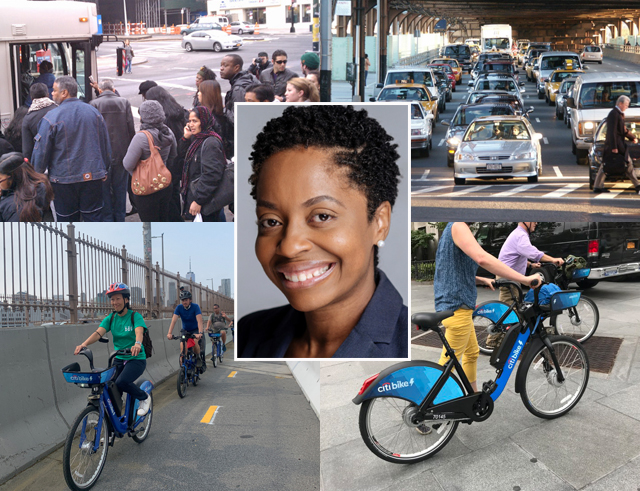Queens Council Member Selvena Brooks-Powers, who chairs the Council's newly created Transportation and Infrastructure Committee, framed the work she plans to do around one word: equity.
Brooks-Powers, whose Edgemere, Far Rockaway, Laurelton, Rosedale, and Springfield Gardens district was one of the most dangerous for pedestrians and motorists alike last year, told DOT Commissioner Ydanis Rodriguez that she would ultimately judge his agency's success on how well it extends the benefits of safe streets and good transit to all the city's neighborhoods — rich and poor.
She questioned how he'll be able to do that given that DOT's top leadership is 63 percent White — in a city that is only 31 percent White. (DOT's overall staff is 53 percent people of color, Rodriguez said.)
Very little news was made at the hearing, so Streetsblog is publishing Brooks-Powers's full opening statement, so readers can get a sense of where she wants to take the Transportation Committee, formerly led by Rodriguez:
For too long, the Council and the city’s transportation conversations have focused on communities – both geographic and otherwise – that are transit rich, and best able to navigate our city’s streets, sidewalks, waterways and subways. Today’s hearing is the start of a new chapter. Under my leadership, the Transportation and Infrastructure Committee will focus on communities that have long been left out of our critical transportation and infrastructure discussions.
“Transportation Equity” sounds like an ambitious topic to tackle in our first hearing — and it is — because equity in transportation means many things. Equity in transportation means addressing the needs of neighborhoods that have suffered from long and dangerous commutes after decades of under-investment. But, it also means making our streets and public transportation accessible for people with disabilities, ensuring our children are safe going to and from school, promoting the use of minority and women-owned businesses when we allocate our transportation dollars, and focusing on improvement — not just enforcement — when we tackle dangerous driving. Fundamentally, transportation equity means listening to the needs of all of our communities, and prioritizing those people and places that need our efforts and resources most.
"All New Yorkers suffer when our streets aren't safe." –@CMBrooksPowers
— Transportation Alternatives *Vote on Sammy's Law* (@TransAlt) March 7, 2022
Because of a lack of historical investment by the city, more traffic deaths occurred last year in District 31 in Queens.
We can change this by focusing on communities long left out of the conversation. pic.twitter.com/9JCNQWxqjt
Many of the challenges we will discuss today are issues that matter citywide, and I’m excited to tackle the issues that all New Yorkers face. But it’s also important that we remember how these “citywide” issues disproportionately affect some more than others, and question why that is and what we can do to change that.
One example of that is street safety. All New Yorkers suffer when our streets aren’t safe, and no Council district is immune from the impacts of traffic deaths. But because of a lack of historical focus or investment from the city, districts like mine — the 31st district in Southeast Queens, where more traffic deaths occurred last year than anywhere else in the City — more of our friends and families hurt and killed on our streets and sidewalks. The same situation holds true in other districts, from the Bronx to Staten Island. And these disproportionate effects aren’t limited to issues of safety, as the data shows that the same holds true when it comes to traffic pollution and lack of accessible infrastructure and other problems.
I also want to make sure that when we are addressing these big issues, our city agencies are responsive to the individual needs of the communities they are working in. That means taking community input seriously, and understanding that one solution will not work for every block in the city. As chair of this committee, I will work to make sure all of our communities’ voices are heard.






